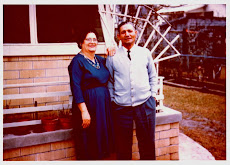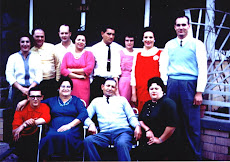
Nona's favorite Christmas song was "Silver Bells." When I was a little girl, I thought "the city" in the song was New Orleans. It was the biggest (and only real) city I knew and my favorite place on Earth -- especially at Christmas.
Some four decades later, I've traveled much farther to much bigger cities. But New Orleans still is most dear to my heart -- well, except maybe for Paris.
My most treasured New Orleans memories date from December 1968 when we lived in the CBD.
My father was then the food and beverage director for Kolb's restaurant on St. Charles, a New Orleans institution, and the lunch spot for the city's downtown businessmen and shoppers. We lived upstairs on the third floor.
That old building was a den of curiosities, the type any eight-year-old dreams of exploring. Though the restaurant sold as much remoulade and red snapper as it did schnitzel and bratworst, the vibe was definitely Old Bavarian with a pulley style fan system operated by a giant Ludwig, a glass case filled with vintage beer steins and a china cabinet of delicate Bavarian china figurines, including an 18th century card game and a young courting couple.
Some four decades later, I've traveled much farther to much bigger cities. But New Orleans still is most dear to my heart -- well, except maybe for Paris.
My most treasured New Orleans memories date from December 1968 when we lived in the CBD.
My father was then the food and beverage director for Kolb's restaurant on St. Charles, a New Orleans institution, and the lunch spot for the city's downtown businessmen and shoppers. We lived upstairs on the third floor.
That old building was a den of curiosities, the type any eight-year-old dreams of exploring. Though the restaurant sold as much remoulade and red snapper as it did schnitzel and bratworst, the vibe was definitely Old Bavarian with a pulley style fan system operated by a giant Ludwig, a glass case filled with vintage beer steins and a china cabinet of delicate Bavarian china figurines, including an 18th century card game and a young courting couple.
But it was the restaurant's downtown setting that really provided the Christmastime magic that helped me forget that I didn't live in a house with a yard in a neighborhood full of kids.
In addition to the wonderful Mr. Bingle marionette shows and toy department at Maison Blanche department store on Canal Street, there were the ornate window displays at MB's rival , D. H. Holmes, the equal of any I've seen in New York or Paris.
That year, one window recreated an animated London Christmas straight out of Dickens, complete with an elderly lady roasting chestnuts, a roguish street urchin picking pockets and a Gothic cathedral that swung open its doors to reveal a golden Nativity scene against a red velvet back drop.
In the opposing window, opulent masked 18th century revelers garbed in pale blue, white and silver brocade, satin and fur, promenaded endlessly through arched white columns in a recreation of a Venetian Twelfth Night Ball.
A giant Santa Claus graced the facade of the downtown Sears at Common and Baronne where I jonesed over a jewelry box shaped like a Swiss chalet. A windmill wound up the music box to make the little ballerina inside twirl to the tinkling melody of "Fascination." A secret velvet-lined drawer under the windmill was the perfect place to hide my only piece of "real" jewelry, a birthstone ring.

On Sunday mornings, my mother and I attended eight o'clock Mass at the Jesuit Church of the Immaculate Conception on Baronne and afterward peeked in at the infamous lobby of the Roosevelt Hotel, then officially called the Fairmont though everyone still called it the Roosevelt.
We shopped for Christmas treats at the only grocery store near us -- the tiny A&P in the French Quarter, and in spite of the winter chill, enjoyed chocolate or strawberry sodas at the Walgreen's lunch counter.
While the rest of New Orleans headed to Kolb's after a busy day of shopping, our favorite downtown dining spot was the old Morrison's cafeteria on Gravier, the most beautiful cafeteria dining room I have ever seen. It was like eating in the square in Old Mexico with Spanish tiled floors, a twinkling "starlit" sky, and the facade of an old tiled-roof village with grille-work balconies and candlelit windows. I believe there was even a fountain.
We moved from New Orleans early in 1969, and though I have been back to the city many, many times since then, until this past weekend, I had never been back at Christmas time.
Most of my old haunts -- Maison Blanche, D. H. Holmes, the downtown Sears, Kolbs and the Morrison's ain't dere no mo'.
We shopped for Christmas treats at the only grocery store near us -- the tiny A&P in the French Quarter, and in spite of the winter chill, enjoyed chocolate or strawberry sodas at the Walgreen's lunch counter.
While the rest of New Orleans headed to Kolb's after a busy day of shopping, our favorite downtown dining spot was the old Morrison's cafeteria on Gravier, the most beautiful cafeteria dining room I have ever seen. It was like eating in the square in Old Mexico with Spanish tiled floors, a twinkling "starlit" sky, and the facade of an old tiled-roof village with grille-work balconies and candlelit windows. I believe there was even a fountain.
We moved from New Orleans early in 1969, and though I have been back to the city many, many times since then, until this past weekend, I had never been back at Christmas time.
Most of my old haunts -- Maison Blanche, D. H. Holmes, the downtown Sears, Kolbs and the Morrison's ain't dere no mo'.

However, our little A&P, little changed, still operates down in the Quarter as Rouse's. The Fairmont is now officially restored to its former glory and called the Roosevelt once more. Its Christmas lobby is still a treat to behold. Across the street, the Jesuit church has also been spiffed up. The Walgreens, too, still stands, and for all I know still sells the world's best chocolate sodas.
However, these days, my shopping break libation of choice is a Sazerac in the Roosevelt's Sazerac Bar.
However, these days, my shopping break libation of choice is a Sazerac in the Roosevelt's Sazerac Bar.

Turtle Soup
Perhaps Kolb's most beloved dish was their turtle soup. I remember one salesman ordered a big bowl of it every time he made a sales call and bought a gallon to take home. I haven't been able to find Kolb's recipe, but here's an authentic Creole turtle soup recipe from the blog Nola Cuisine



